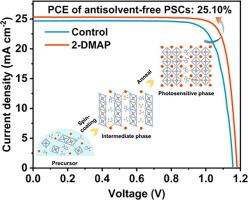双时间尺度结晶工程使α-FAPbI3直接形成高效无溶剂钙钛矿太阳能电池
IF 14.9
1区 化学
Q1 Energy
引用次数: 0
摘要
FAPbI3由于其良好的带隙和优异的光电性能被广泛应用于高性能钙钛矿太阳能电池(PSCs)中。然而,在结晶过程中,它很容易形成光非活性的δ相,并且在无抗溶剂的制造工艺中获得高质量的α相薄膜变得更加具有挑战性。本研究引入了基于2-二甲氨基吡啶(2-DMAP)配体工程的结晶控制策略,建立了“快成核-慢生长”的双时域结晶机制。2-DMAP促进形成功能性中间相(2-DMAP·PbI2·DMSO),使α-FAPbI3相直接转化,并有效抑制δ相途径。理论计算和系统的实验表征表明,2-DMAP比二甲基亚砜(DMSO)具有更强的结合亲和力和更大的电荷极化效应。这促进了自旋涂层过程中高密度核的形成,并延缓了退火过程中过度的晶粒生长,从而导致钙钛矿薄膜结晶度提高,缺陷减少,载流子寿命更长。结果,成功地制造了一种无抗溶剂的PSC器件,实现了25.10%的功率转换效率(PCE),这是无抗溶剂旋转涂层系统中最高的功率转换效率之一。在iso - l -1标准条件下,该装置在连续照明1500 h后仍保持其初始效率的84.78%,表现出优异的工作稳定性。此外,它在恶劣的湿热条件下表现出显著的长期稳定性。这项工作为大规模制造高性能和无抗溶剂聚氯乙烯提供了有价值的策略。本文章由计算机程序翻译,如有差异,请以英文原文为准。

Dual-timescale crystallization engineering enabling direct α-FAPbI3 formation for high-efficiency antisolvent-free perovskite solar cells
FAPbI3 has been extensively employed in high-performance perovskite solar cells (PSCs) owing to its optimal bandgap and outstanding optoelectronic properties. Nevertheless, it readily undergoes the formation of a photo-inactive δ-phase during crystallization, and achieving high-quality α-phase films becomes even more challenging in antisolvent-free fabrication processes. This study introduces a crystallization control strategy based on 2-dimethylaminopyridine (2-DMAP) ligand engineering to establish a “fast nucleation-slow growth” dual-time-domain crystallization mechanism. 2-DMAP facilitates the formation of a functional intermediate phase (2-DMAP·PbI2·DMSO) that enables a direct transformation to the α-FAPbI3 phase and effectively suppresses the δ-phase pathway. Theoretical calculations and systematic experimental characterizations demonstrate that 2-DMAP exhibits stronger binding affinity and a greater charge polarization effect than dimethylsulfoxide (DMSO). This promotes the formation of high-density nuclei during spin coating and delays excessive grain growth during annealing, leading to perovskite films with improved crystallinity, fewer defects, and longer carrier lifetimes. As a result, an antisolvent-free PSC device was successfully fabricated, achieving a power conversion efficiency (PCE) of 25.10 %, one of the highest reported for antisolvent-free spin-coating systems. Under ISOS-L-1 standard conditions, the device retained 84.78 % of its initial efficiency after 1500 h of continuous illumination, demonstrating excellent operational stability. Moreover, it exhibited remarkable long-term stability under harsh humid and thermal conditions. This work offers a valuable strategy for the large-scale fabrication of high-performance and antisolvent-free PSCs.
求助全文
通过发布文献求助,成功后即可免费获取论文全文。
去求助
来源期刊

Journal of Energy Chemistry
CHEMISTRY, APPLIED-CHEMISTRY, PHYSICAL
CiteScore
19.10
自引率
8.40%
发文量
3631
审稿时长
15 days
期刊介绍:
The Journal of Energy Chemistry, the official publication of Science Press and the Dalian Institute of Chemical Physics, Chinese Academy of Sciences, serves as a platform for reporting creative research and innovative applications in energy chemistry. It mainly reports on creative researches and innovative applications of chemical conversions of fossil energy, carbon dioxide, electrochemical energy and hydrogen energy, as well as the conversions of biomass and solar energy related with chemical issues to promote academic exchanges in the field of energy chemistry and to accelerate the exploration, research and development of energy science and technologies.
This journal focuses on original research papers covering various topics within energy chemistry worldwide, including:
Optimized utilization of fossil energy
Hydrogen energy
Conversion and storage of electrochemical energy
Capture, storage, and chemical conversion of carbon dioxide
Materials and nanotechnologies for energy conversion and storage
Chemistry in biomass conversion
Chemistry in the utilization of solar energy
 求助内容:
求助内容: 应助结果提醒方式:
应助结果提醒方式:


